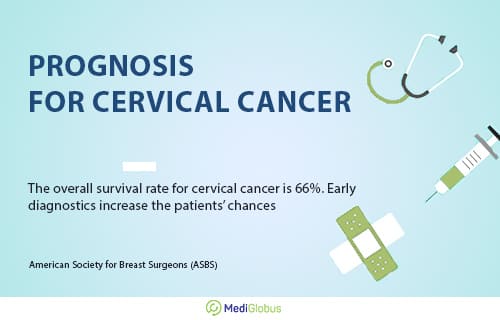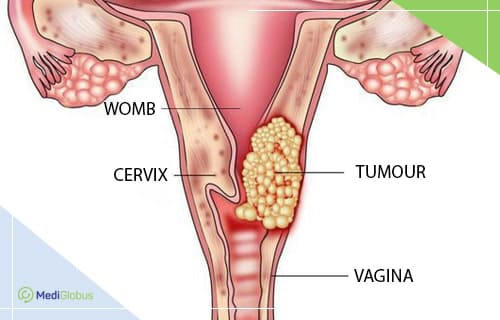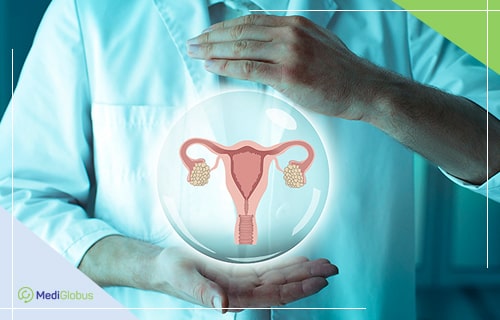1. Life expectancy on 0 stage
|
2. Early stage survival rate
|
3. Stage 2 prognosis
|
4. Life expectancy at stage 3
|
5. Survival rate for 4 stage
|
6. Survival rate for an untreated disease
|
7. Leading clinics
|
According to the International Agency for Research on Cancer, 604,000 women were diagnosed with cervical cancer in 2020. About 341,000 of those cases were lethal. The disease is most commonly diagnosed in women who are 30-65 years old. The average age at diagnosis is 50 years. The disease rarely occurs in girls younger than 20 years or older women. In 9 out of 10 cases, the pathology is caused by papillomavirus. Early diagnosis and comprehensive treatment help achieve the best survival rate. Find out how life expectancy differs at different stages of cancer development in this article.
Listen to the article:
Life expectancy at stage 0 cervical cancer
At 0 stage, the malignant cells affect only the surface of the organ. This stage is not included in the International Federation of Gynecology and Obstetrics (FIGO) system and is called “in situ” carcinoma.
“Zero stage” cervical cancer is curable. Patients undergo surgery to remove the tumour. More than 99% of women pass the 5-year survival threshold.

At this stage, the disease has no symptoms. Therefore, it is only possible to detect the development of the disease during gynaecological examinations.
At stage 0, the disease is diagnosed in women between the ages of 31 and 36. Only 7% of women manage to detect the disease of the “in situ” stage.
Life expectancy also depends on the age of the patient. The younger the woman, the higher the chances of remission. The overall 5-year survival rate according to the age criterion is:
30-40 years old – 93%
40-55 years old – 72%
over 55 years old – 49%
CONTACT MEDIGLOBUS
We organize medical trips. We assist in finding a clinic, a doctor and the best treatment methods. MediGlobus is constantly in touch with patients from the moment of application until the return to the home country after treatment
What not to do after cervical cancer surgery?
After cervical cancer surgery, patients should strictly follow their doctor’s advice. This will provide a quicker recovery and help to avoid serious complications from the procedure. For a few weeks after surgery, you should avoid lifting weights, exercising and other physical activities that may affect the healing of wounds. During this time, women should also avoid sexual activity.
How long do people live after uterus removal?
Survival for cervical cancer depends directly on the stage of the disease, the patient’s general health and age, and the methods used to fight the disease. Patients can live for more than a year after cervical cancer surgery. However, about 90% of women with early-stage unresectable cervical cancer who have had a hysterectomy will live 5 years or more (according to the online edition of Medical News Today).
The survival rate for stage 1 cervical cancer
The International Federation of Gynecology and Obstetrics (FIGO) classifies cervical cancer into 4 stages. Generally, an initial stage cancer is detected during cervical screening or ultrasound examination.
In the first stage of disease development, the malignant cells are limited to the organ. They do not spread to neighbouring tissues or other organs. This stage has 2 groups: 1A and 1B. They are also divided into several subtypes.
The 5-year survival rate of patients for each stage is as follows:
Stage 1A1 – cancer has penetrated organ tissue less than 3 mm – 95%
Stage 1A2 – tumor has penetrated 3-5 mm of organ tissue – 90%
Stage 1B1 – 1-2 cm in size – 80%
Stage 1B2 – tumor size 2 to 4 cm – 75%
Stage 1B3 – tumor larger than 4 centimeters – 65%

The survival rate is influenced by the age of the patient, the presence of comorbid pathologies, the treatment program, and the patient’s lifestyle. The younger the patient, the higher the chances of winning the fight against the disease. The overall 5-year survival rate for cervical cancer is 66%.

For most patients, surgery is the mainstay of treatment. The severity of the intervention depends on the course of the malignant process and the need to preserve fertility. Abroad, about 80% of patients with stage 1 oncology can save the possibility of having a child in the future.
According to Dr Gökhan Demirayak(Memorial Hospital) : “In the early stages of the disease, complete removal of the uterus can be avoided. Remission can be achieved by partial resection of the cervix with a simple surgical procedure called LEEP, conisation.”
Additional treatments, such as radiation and chemical therapy, are recommended to kill residual cancer cells and reduce the risk of disease recurrence.
CURE THE INITIAL STAGE OF THE DISEASE ABROAD
After you leave an application online, expect a call from our coordinator. We will contact you within 30 minutes and answer all your questions about your medical problem
How quickly does cervical cancer develop?
To answer the question of how quickly cervical cancer develops, it is also worth discussing the life prognosis for cervical dysplasia. It is a precancerous condition that involves abnormal growth of cells on the surface of the cervix.
However, not all patients with dysplasia develop cancer. The process of changing from benign to malignant cells can take several decades.
Cervical cancer is a slow-growing form of cancer. In women with a healthy immune system it may take 15-20 years from the appearance of dysplasia to the development of cancer, and for women with a weaker immune system it may take 5-10 years. However, the correct treatment of even grade 3 dysplasia can prevent the formation of cancer.
How long do people live with Stage II cervical cancer?
Stage II tumour has spread beyond the organ and affected the upper two-thirds of the vagina or other neighbouring tissues. Doctors distinguish two subgroups of the disease – 2A and 2B. Life expectancy with stage 2 cervical cancer is:
Stage 2A – 4-5 cm tumor without lymph node involvement – 73% to 90%
Stage 2B – the tumor has affected tissues around the organ and lymph nodes – 60% to 84%
The surgery is indicated for stage 2A disease. It involves complete removal of the womb and cervix – a radical hysterectomy.
The doctor also performs resection of the pelvic lymph nodes. The patient then receives a course of chemicals and radiation.
Radiotherapy is indicated for 5 weeks and chemo for 2-3 weeks. The use of targeted drugs is possible.

For stage 2A and 2B cancers, 77% of patients survive for five years or more. This figure is typical for patients who receive chemotherapy and radiation therapy at the same time. Less than 50% of patients reach the 5-year milestone if they’ve received radiation therapy alone.
How long do people live with stage 3 cervical cancer?

In the third stage of the disease, cancer cells are found in the lymph nodes and abdominal cavity. A combination of chemotherapy and radiation therapy is indicated to treat the pathology.
Such a stage is divided into substages: 3A, 3B, and 3C. The latter, in turn, has subtypes: 3C1 and 3C2. The life expectancy of patients according to this classification is:
Grade 3A – the tumor is found on the lower third of the vagina – 50%
Grade 3B – the tumour has reached the pelvic wall or is blocking the ureter – 40%
Grade 3C – tumour of any size that has invaded the abdominal or pelvic lymph nodes – 30%
Can one die from cervical cancer?
Like all cancers, cervical cancer can be fatal. Without early detection and treatment of the disease, the prognosis is notoriously poor. Metastatic cervical cancer causes death within a few years.
How long does one live with cervical sarcoma?
Primary cervical sarcoma is a rare type of cancer. It has a worse survival prognosis than squamous cell cancer and adenocarcinoma. According to the US National Library of Medicine website, the five-year overall survival rate at all stages was 63,3% for squamous cell cervical cancer, 73,7% for adenocarcinoma and 47,7% for sarcoma.
The prognosis for stage 4 cervical cancer
At this stage of cervical cancer, the disease has affected nearby organs or other parts of the body. Stage 4 is divided into two subcategories:
4A – the tumour has affected the bladder or rectum but has not affected distant parts of the body.
4B – Cancer cells are in the lungs, liver, or bones.
For stage 4 of the disease, the survival rate of patients does not exceed 19%. To slow down the progression of the pathology, chemotherapy is combined with radiation. Surgery is not performed at this stage.

Survival rate by cervical cancer histotype
Malignant neoplasms of the cervix are divided into 2 main histological types: squamous cell tumours and adenocarcinomas. Squamous cell cancer accounts for more than 90% of all cases. For adenocarcinoma, the statistics are less optimistic. This is because such tumours are less often detected at an early stage.
Overall 5-year survival rates by stage and tumour histotype
| Disease stage | Squamous cell carcinoma | Adenocarcinoma |
|---|---|---|
| Stage 1 | 94,1% | 75,5% |
| Stage 2 | 81,7% | 64,2% |
| Stage 3 | 45,8% | 34,6% |
| Stage 4 | 19,2% | 12,1% |
How long do people live with cervical cancer if left untreated?
If left untreated, these malignant tumours progress rapidly. They affect the bladder, intestines, lymph nodes, bones, lungs, and liver. Without treatment, terminal oncopathology is fatal within two to three years.
Seek help from an overseas clinic
Leading clinics for cervical cancer treatment abroad
Patients often go to Turkish, German, Spanish and Czech clinics for cervical cancer treatment. Among the medical institutions in these countries, cervical cancer is particularly popular:
CHOOSE YOUR CLINIC
Cervical cancer is curable in its early stages. Some medical centres abroad show high success rates of treatment, even for neglected pathologies. Do not miss the opportunity to get rid of the disease – contact us. We will choose the clinic that best meets your requirements.
Resume
Stage 0 cervical cancer is called “in situ” carcinoma. Only a small number of women manage to detect the tumour at this stage. The prognosis is favourable.
The 5-year life expectancy for stage 1 uterine cancer is 65-95%. This is one of the most optimistic and high rates. Early diagnosis and the right oncotherapy program allow some patients to be cured and remain fertile.
If no metastases are found in stage 2 cancer, then the treatment prognosis is favorable. If there are cancer cells in the lymph nodes, the survival rate for stage 2 cervical cancer is 60-75%.
The 5-year life expectancy after removal of stage 3 cervical cancer is 30-50%.
The overall survival rate after grade 4 cervical cancer is less than 19%.
About 46% of patients with adenocarcinoma pass the 5-year threshold, and for squamous cell tumours, the overall rate is 60%.
Without treatment, patients with advanced cervical cancer live for about two to three years.
For the treatment of this disease, foreign patients choose clinics such as Medicina, Motol, Navarra, Liv, Anadolu and Cologne.
GET IN TOUCH
If you have any questions about treatment abroad, please contact us. We value your time, so we will answer quickly!
Sources:
- American Cancer Society
- National Center for Biotechnology Information
- ACS Journals
- National Center for Biotechnology Information
- Medical News Today
- Cancer Council NSW
- Medical News Today
- Verywell Health
- Cleveland Clinic
- National Library of Medicine












Comments